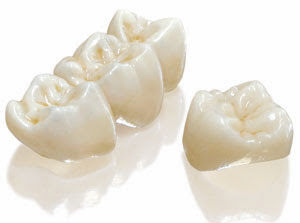 | |
| Dental Porcelain Crowns |
Dental crowns (ie. gold, porcelain fused to metal, and all porcelain) are used to reinforce a tooth's structural integrity and to allow normal functional occlusion.
But what makes the crown stay on the tooth? A crown's retention is dependent on the following factors:
1) Taper. The prepared tooth should ideally have 3 to 5 degrees of taper to allow for the restoration to be properly placed on the tooth. There should be no undercuts, as the restoration will not be able to be removed from the die and from the prepared tooth. Conversely excess taper will limit the grip that the crown has on the prep, thus contributing to debonding of the restoration. Generally 6° of taper around the entire circumference of the prepared tooth, giving a combined taper of 12° at any given axial section through the prep is appropriate to both allow the crown for a proper fit and to allow enough retention.
2) Prep length. The prepared tooth should also ideally have a minimum occlusal-gingival height of 4mm for molars and 3mm for anterior and premolars. When such prep height is not possible, sometimes a core buildup is necessary to allow sufficient height and crown retention.
3) Adhesion. There are two fundamental types of dental cements available, resin-based and acid-base cements. Such cements allow the crown to adhere to the tooth by forming a chemical bond with the dentin and enamel. The cement also forms an insulating and protective layer around the pulp.
If you have additional questions on the process of making sure a crown has sufficient retention, be sure to ask your family dentist.
From your family dentist in Bellevue,
Dr. Peter Chien
info@bellevuefamilydentistry.com
www.bellevuefamilydentistry.com


